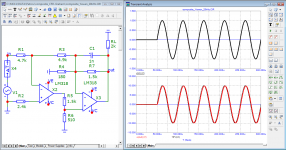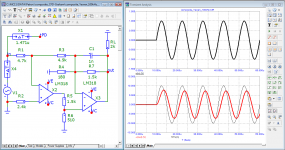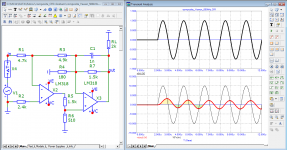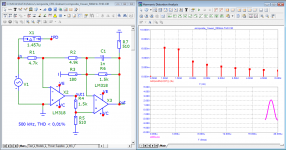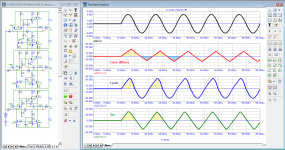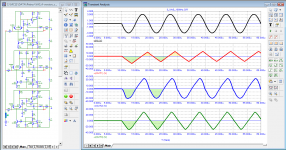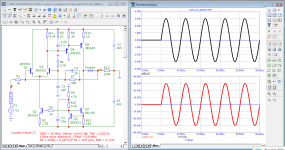Successive transients with a very short time frame?I'd love to see a credible theory why faster is better. IIRC when we looked for any examples in real music of a transient that would trouble even the lowest of slew rate amplifiers none was found. So if all these people 'hear' something better with faster amplifiers what is going on other than delusion?
Successive transients with a very short time frame?
Isnt that more of a power feed challenge? Else it's FFT denial...
//
Sine wave and square wave of f=11kHz have easily distinguishable sound. Unlike the sine, square wave contains harmonics at 22kHz, 33kHz,...
However, those harmonics fall outside of audible band and are not suppose to make any difference. And yet in real life we hear the difference. That's argument why it's important to pay due attention to supersonic region when designing audio circuits.
However, those harmonics fall outside of audible band and are not suppose to make any difference. And yet in real life we hear the difference. That's argument why it's important to pay due attention to supersonic region when designing audio circuits.
OPINION WARNING (CAUTION!):
My audio designer friends tell me a power amp needs to have a sufficient slew rate but not more than that. They also say an amplifier that sounds good does so for various reasons. Part of it has to do with what sounds like real music to humans. Billshurv described a personal like of an immersive listening experience, even if its not what a real concert hall sounds like. That type of experience is what I am told audiophiles seek. Certain nonstationary low-level low-order nonlinearity can add a subtle dynamic perceptual dimension to music reproduction that elicits a positive emotional experience in at least some humans. Its for reasons like that something like John Curl amplifiers may earn high ratings from reviewers while not measuring the lowest distortion and noise possible.
I have played around some with the tuning of such a dynamic effect using AK4499. Very interesting to watch people react as they listen to it.
</OPINION>
My audio designer friends tell me a power amp needs to have a sufficient slew rate but not more than that. They also say an amplifier that sounds good does so for various reasons. Part of it has to do with what sounds like real music to humans. Billshurv described a personal like of an immersive listening experience, even if its not what a real concert hall sounds like. That type of experience is what I am told audiophiles seek. Certain nonstationary low-level low-order nonlinearity can add a subtle dynamic perceptual dimension to music reproduction that elicits a positive emotional experience in at least some humans. Its for reasons like that something like John Curl amplifiers may earn high ratings from reviewers while not measuring the lowest distortion and noise possible.
I have played around some with the tuning of such a dynamic effect using AK4499. Very interesting to watch people react as they listen to it.
</OPINION>
Last edited:
Have you followed up on how they listened or did you just swallow whatever they say?They also say an amplifier that sounds good does so for various reasons.
Has a lot to do with the quality of recording, speakers and room acoustics. Nothing to do with present day DACs, amps and audio cables that meet the basic industry standard.Part of it has to do with what sounds like real music to humans. Billshurv described a personal like of an immersive listening experience, even if its not what a real concert hall sounds like.
Have you followed up on how they obtained that info such as polling size, date or location?That type of experience is what I am told audiophiles seek.
It may, meaning that it's a speculation?Certain nonstationary low-level low-order nonlinearity can add a subtle dynamic perceptual dimension to music reproduction that elicits a positive emotional experience in at least some humans. Its for reasons like that something like John Curl amplifiers may earn high ratings from reviewers while not measuring the lowest distortion and noise possible.
How was the listening rig set up? Any details on bias control or level matching?I have played around some with the tuning of such a dynamic effect using AK4499. Very interesting to watch people react as they listen to it.
I'm not criticizing you for having opinion but just following up on what your opinion is based on.</OPINION>
Transients can be generated by nonlinearity in the circuit, e.g. crossover distorsion, class D, etc. Speed FB amp copes better with the artefacts.
What is 'speed FB'? Makes no sense.
First cycle test
Sorry I couldn't find: was there an original article about this concept?
Anyways I'd guess the point is to test a system after it
reached its steady state (without signal at the input)
and then apply only one cycle, as this method can be more relevant
regarding transient behaviour as a conventional test with continous
repetitive sine waves or even square waves.
Maybe this method helps to magnify the behaviour to random changes which
can be relevant even with real life music signal as it is also "random".
What if there is some "distortion overshoot" kind of problem
at the very first change which then "settles" to the 10th period?
What if the change of distortion in time is one of the most
annoying factor to our ears?
Square wave vs real life signal
I never understood why this method is controversial based on
the concept that real life music doesn't have such waveforms.
It's just a technical method for development and testing purposes.
Of course it's a much cruel drive but thats how we can zoom in
to some transient glitches in the amplification process.
Sorry I couldn't find: was there an original article about this concept?
Anyways I'd guess the point is to test a system after it
reached its steady state (without signal at the input)
and then apply only one cycle, as this method can be more relevant
regarding transient behaviour as a conventional test with continous
repetitive sine waves or even square waves.
Maybe this method helps to magnify the behaviour to random changes which
can be relevant even with real life music signal as it is also "random".
What if there is some "distortion overshoot" kind of problem
at the very first change which then "settles" to the 10th period?
What if the change of distortion in time is one of the most
annoying factor to our ears?
Square wave vs real life signal
I never understood why this method is controversial based on
the concept that real life music doesn't have such waveforms.
It's just a technical method for development and testing purposes.
Of course it's a much cruel drive but thats how we can zoom in
to some transient glitches in the amplification process.
of it has to do with what sounds like real music to humans. Billshurv described a personal like of an immersive listening experience, even if its not what a real concert hall sounds like.
That's not quite what I said. I said I want the immersive soundfield, which is impossible with 2 channels. The pinpoint imaging that you get with a good system is the 'unreal' part as that does not match the concert experience. But it's a nice trick and enjoyable to listen to.
I did these test when I was younger and did not perceive a difference. Did you match levels? With same amplitude the square wave fundamental is louder!Sine wave and square wave of f=11kHz have easily distinguishable sound. Unlike the sine, square wave contains harmonics at 22kHz, 33kHz,...
However, those harmonics fall outside of audible band and are not suppose to make any difference. And yet in real life we hear the difference. That's argument why it's important to pay due attention to supersonic region when designing audio circuits.
Here is an example of an amplifier that introduces predominantly linear distortion in steady state (amplitude reduction and phase shift). At 20 kHz, there is a barely noticeable decrease in amplitude and a barely noticeable phase shift. Let's increase the frequency to 100 kHz. Here we can already see clearly pronounced linear distortions. Let's go further and increase the frequency to 500 kHz (the period of 2 μs is comparable to the signal transit time of 1.5 μs). Here, in addition to the phase shift, we see a decrease in the signal in amplitude by more than 3 times. To make sure that there is no harmonic distortion in the linear mode, measure the THD level at a frequency of 500 kHz, it turns out THD <0.01%!
regards
Petr
regards
Petr
Attachments
These are the basic design principles for audio amplifiers that I fully share. This is in good agreement with what Graham Maynard tried to convey to the forum participants.# Is there a way to do "first cycle" surgical analysis? A scope wont do it - right!?
# What shall (a set of?) stimuli be?
# How is it to be analyses and with what accuracy? (Can FFT do it?)
# Criteria for HIFI performance?
Herve Deletraz Interview with Mike Malinowksi | Audio Reference Co.
Mike Malinowksi
[snip]
If you have only 1 percent harmonic distortion compared to 20 or 30 percent of natural harmonics, you don't hear a difference. So my quest for this amp was more for speed, less phase shift and simplicity of the circuit.
I design first using a computer simulation to make sure that the electronic design works. We then build a bread board prototype. We listen intensely and after we are satisfied, we move to a circuit board and listen again. Listening is the most important part in the design process.
Temporal distortion occurs when you have phase shift on the bottom or the top. Reviewers might
measure the square wave response of high frequencies. I've never seen a square wave response of a very
low frequency. Normally an amp begins to show measurements at 100Hz. To have the plateau tilting
indicates phase shift. An amp going down to 10 or 20Hz might have an excellent rise time but the plateau
is tilted.
Ideally, the amplifying circuit should go 10 times lower and 10 times higher than the audio band to have correct phase shift. Our circuits go 50 times lower and 50 times higher. Square waves are a very
helpful design tool. You can see a lot of things. At 20Hz we are quasi flat; the phase shift is less than one
degree at 20Hz. In the high frequency, we extend to about one megahertz - 50 times more than 20
kilohertz to attain about one degree of phase shift at 20 kilohertz.
[snip]
What is 'speed FB'? Makes no sense.
OK, 'speed' amplifier closed with negative feedback, aka wide GBW.
# Is there a way to do "first cycle" surgical analysis? A scope wont do it - right!?
# What shall (a set of?) stimuli be?
# How is it to be analyses and with what accuracy? (Can FFT do it?)
# Criteria for HIFI performance?
//
In the days people still understood what they were talking about we'd do an impulse response measurement and then went to lunch.
Jan
I did these test when I was younger and did not perceive a difference. Did you match levels? With same amplitude the square wave fundamental is louder!
No level matching, just flipping the switch on a tone generator. As far as I remember, the difference was not the 'quantity' but the 'quality' of the tone.
Any way, my point was exciting an imperfect audio device with ultrasoninc content may produce audible artefacts. Good designs should not (perhaps 'bare ear' also produces artefacts by itself, but I don't know the answer and that is different topic).
One could argue music recordings are band limited so this should not be an issue. Still there are several known potential sources like DACs (especially NOS, and DSD), RFI, EMI, output stage Class B, D, H, etc. (Perhaps that's why in some exotic high end systems analog sounds so much better than digital, i.e. dac gives hard time to the amp).
Some authors argue that TIM distortion does not exist, they say these are ordinary nonlinear distortions. In my opinion, TIM distortion is a dynamic distortion associated with a specific limitation of the slew rate of the output voltage, which leads to the fact that the output signal turns into a triangle. However, not all SR limited amplifiers are prone to this kind of distortion, as I showed with the composite amplifier.
Dynamic distortions significantly depend on the used correction to obtain stability margins. Only one of the 4 types of correction gave a positive result, and only one of the 4 options is capable of operating at a frequency of 200 kHz.
Dynamic distortions significantly depend on the used correction to obtain stability margins. Only one of the 4 types of correction gave a positive result, and only one of the 4 options is capable of operating at a frequency of 200 kHz.
Attachments
In the days people still understood what they were talking about we'd do an impulse response measurement and then went to lunch.
Jan
Yes - this was what I anticipated...
- What pulse shape?
- What pulse time?
- "Passed" criteria?
- What for lunch?
//
- Home
- Amplifiers
- Solid State
- First cycle distortion - Graham, what is that?
